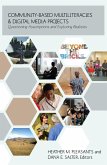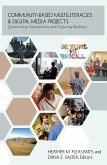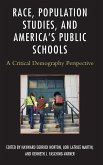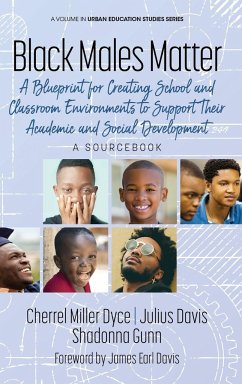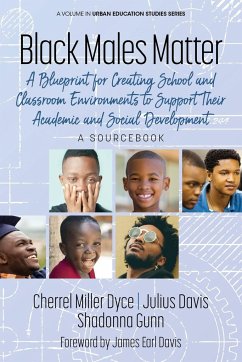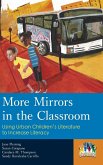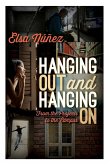Connie L. Schaffer, Meg White, Corine Meredith Brown
Questioning Assumptions and Challenging Perceptions
Becoming an Effective Teacher in Urban Environments
Connie L. Schaffer, Meg White, Corine Meredith Brown
Questioning Assumptions and Challenging Perceptions
Becoming an Effective Teacher in Urban Environments
- Gebundenes Buch
- Merkliste
- Auf die Merkliste
- Bewerten Bewerten
- Teilen
- Produkt teilen
- Produkterinnerung
- Produkterinnerung
Within a framework of cognitive dissonance, readers will continuously examine and reexamine their personal beliefs and perceptions. Readers will also investigate new information and varied perspectives related to urban schools. When readers finish this book, they will be on their way to becoming effective teachers in urban environments.
Andere Kunden interessierten sich auch für
![Community-Based Multiliteracies and Digital Media Projects Community-Based Multiliteracies and Digital Media Projects]() Community-Based Multiliteracies and Digital Media Projects41,85 €
Community-Based Multiliteracies and Digital Media Projects41,85 €![Community-Based Multiliteracies and Digital Media Projects Community-Based Multiliteracies and Digital Media Projects]() Community-Based Multiliteracies and Digital Media Projects166,10 €
Community-Based Multiliteracies and Digital Media Projects166,10 €![Race, Population Studies, and America's Public Schools Race, Population Studies, and America's Public Schools]() Race, Population Studies, and America's Public Schools116,99 €
Race, Population Studies, and America's Public Schools116,99 €![Black Males Matter Black Males Matter]() Cherrel Miller DyceBlack Males Matter106,99 €
Cherrel Miller DyceBlack Males Matter106,99 €![Black Males Matter Black Males Matter]() Cherrel Miller DyceBlack Males Matter61,99 €
Cherrel Miller DyceBlack Males Matter61,99 €![More Mirrors in the Classroom More Mirrors in the Classroom]() Jane FlemingMore Mirrors in the Classroom110,99 €
Jane FlemingMore Mirrors in the Classroom110,99 €![Hanging Out and Hanging On Hanging Out and Hanging On]() Elsa NunezHanging Out and Hanging On60,99 €
Elsa NunezHanging Out and Hanging On60,99 €-
-
-
Within a framework of cognitive dissonance, readers will continuously examine and reexamine their personal beliefs and perceptions. Readers will also investigate new information and varied perspectives related to urban schools. When readers finish this book, they will be on their way to becoming effective teachers in urban environments.
Hinweis: Dieser Artikel kann nur an eine deutsche Lieferadresse ausgeliefert werden.
Hinweis: Dieser Artikel kann nur an eine deutsche Lieferadresse ausgeliefert werden.
Produktdetails
- Produktdetails
- Verlag: Rowman & Littlefield Publishers
- Seitenzahl: 112
- Erscheinungstermin: 15. Januar 2016
- Englisch
- Abmessung: 235mm x 157mm x 11mm
- Gewicht: 325g
- ISBN-13: 9781475822021
- ISBN-10: 1475822022
- Artikelnr.: 43894180
- Herstellerkennzeichnung
- Libri GmbH
- Europaallee 1
- 36244 Bad Hersfeld
- gpsr@libri.de
- Verlag: Rowman & Littlefield Publishers
- Seitenzahl: 112
- Erscheinungstermin: 15. Januar 2016
- Englisch
- Abmessung: 235mm x 157mm x 11mm
- Gewicht: 325g
- ISBN-13: 9781475822021
- ISBN-10: 1475822022
- Artikelnr.: 43894180
- Herstellerkennzeichnung
- Libri GmbH
- Europaallee 1
- 36244 Bad Hersfeld
- gpsr@libri.de
Connie Schaffer is a faculty member at the University of Nebraska at Omaha. Her teaching and research focus on preparing pre-service teachers to better understand the context of urban schools and the students who attend them. Meg White is an Assistant Professor in Teacher Education at Stockton University. Currently much of her teaching and scholarship is preparing pre-service teachers to be effective urban educators. Visit her blog: https://reflectionsinedblogblog.wordpress.com/ Corine Meredith Brown is Assistant Chair for the Interdisciplinary and Inclusive Education Department at Rowan University. Her teaching and research focus on pre-service teacher preparation in diverse learning environments.
ABOUT THE COVER ART FOREWORD-JACK MCKAY ACKNOWLEDGEMENTS INTRODUCTION
CHAPTER ONE: PERSONAL EXPLORATION How do you define yourself culturally?
establishing a frame of reference ABC's of cultural understanding and
communication CHAPTER TWO: CREATING A DEFINITION OF URBAN graffiti wall
sphere of influence within the social context definitions of urban based on
population definitions of urban based on social context broadening the
definition of urban moving beyond a single story of urban schools CHAPTER
THREE: THE SOCIAL CONTEXT OF CHILDREN AND FAMILIES IN URBAN ENVIRONMENTS
case study 3.1: the story of amie maslow's identification of human needs
poverty mural the complexities of poverty case study 3.2: the bank street
school CHAPTER FOUR: STAGES OF COGNITIVE DISSONANCE: INTERNAL REFLECTIONS
stages of cognitive dissonance related to urban schools creating the felt
need a kwl chart on urban schools shifting from apprehension to
appreciation culture walks moving beyond the deficit approach common
scenarios CHAPTER FIVE: STAGES OF COGNITIVE DISSONANCE: EXTERNAL
IMPLICATIONS value line part one closing the gaps value line part two
teaching for social justice teaching for social justice gallery walk
CHAPTER SIX: TRANSFORMING KNOWLEDGE INTO ACTION teachers as activists
imagining a socially just classroom personal sphere of influence model
identifying elements in your personal sphere of influence CHAPTER SEVEN:
TRANSLATING THEORY INTO ACTION case study 7.1: Ruby bridges INDEX ABOUT THE
AUTHORS
CHAPTER ONE: PERSONAL EXPLORATION How do you define yourself culturally?
establishing a frame of reference ABC's of cultural understanding and
communication CHAPTER TWO: CREATING A DEFINITION OF URBAN graffiti wall
sphere of influence within the social context definitions of urban based on
population definitions of urban based on social context broadening the
definition of urban moving beyond a single story of urban schools CHAPTER
THREE: THE SOCIAL CONTEXT OF CHILDREN AND FAMILIES IN URBAN ENVIRONMENTS
case study 3.1: the story of amie maslow's identification of human needs
poverty mural the complexities of poverty case study 3.2: the bank street
school CHAPTER FOUR: STAGES OF COGNITIVE DISSONANCE: INTERNAL REFLECTIONS
stages of cognitive dissonance related to urban schools creating the felt
need a kwl chart on urban schools shifting from apprehension to
appreciation culture walks moving beyond the deficit approach common
scenarios CHAPTER FIVE: STAGES OF COGNITIVE DISSONANCE: EXTERNAL
IMPLICATIONS value line part one closing the gaps value line part two
teaching for social justice teaching for social justice gallery walk
CHAPTER SIX: TRANSFORMING KNOWLEDGE INTO ACTION teachers as activists
imagining a socially just classroom personal sphere of influence model
identifying elements in your personal sphere of influence CHAPTER SEVEN:
TRANSLATING THEORY INTO ACTION case study 7.1: Ruby bridges INDEX ABOUT THE
AUTHORS
ABOUT THE COVER ART FOREWORD-JACK MCKAY ACKNOWLEDGEMENTS INTRODUCTION
CHAPTER ONE: PERSONAL EXPLORATION How do you define yourself culturally?
establishing a frame of reference ABC's of cultural understanding and
communication CHAPTER TWO: CREATING A DEFINITION OF URBAN graffiti wall
sphere of influence within the social context definitions of urban based on
population definitions of urban based on social context broadening the
definition of urban moving beyond a single story of urban schools CHAPTER
THREE: THE SOCIAL CONTEXT OF CHILDREN AND FAMILIES IN URBAN ENVIRONMENTS
case study 3.1: the story of amie maslow's identification of human needs
poverty mural the complexities of poverty case study 3.2: the bank street
school CHAPTER FOUR: STAGES OF COGNITIVE DISSONANCE: INTERNAL REFLECTIONS
stages of cognitive dissonance related to urban schools creating the felt
need a kwl chart on urban schools shifting from apprehension to
appreciation culture walks moving beyond the deficit approach common
scenarios CHAPTER FIVE: STAGES OF COGNITIVE DISSONANCE: EXTERNAL
IMPLICATIONS value line part one closing the gaps value line part two
teaching for social justice teaching for social justice gallery walk
CHAPTER SIX: TRANSFORMING KNOWLEDGE INTO ACTION teachers as activists
imagining a socially just classroom personal sphere of influence model
identifying elements in your personal sphere of influence CHAPTER SEVEN:
TRANSLATING THEORY INTO ACTION case study 7.1: Ruby bridges INDEX ABOUT THE
AUTHORS
CHAPTER ONE: PERSONAL EXPLORATION How do you define yourself culturally?
establishing a frame of reference ABC's of cultural understanding and
communication CHAPTER TWO: CREATING A DEFINITION OF URBAN graffiti wall
sphere of influence within the social context definitions of urban based on
population definitions of urban based on social context broadening the
definition of urban moving beyond a single story of urban schools CHAPTER
THREE: THE SOCIAL CONTEXT OF CHILDREN AND FAMILIES IN URBAN ENVIRONMENTS
case study 3.1: the story of amie maslow's identification of human needs
poverty mural the complexities of poverty case study 3.2: the bank street
school CHAPTER FOUR: STAGES OF COGNITIVE DISSONANCE: INTERNAL REFLECTIONS
stages of cognitive dissonance related to urban schools creating the felt
need a kwl chart on urban schools shifting from apprehension to
appreciation culture walks moving beyond the deficit approach common
scenarios CHAPTER FIVE: STAGES OF COGNITIVE DISSONANCE: EXTERNAL
IMPLICATIONS value line part one closing the gaps value line part two
teaching for social justice teaching for social justice gallery walk
CHAPTER SIX: TRANSFORMING KNOWLEDGE INTO ACTION teachers as activists
imagining a socially just classroom personal sphere of influence model
identifying elements in your personal sphere of influence CHAPTER SEVEN:
TRANSLATING THEORY INTO ACTION case study 7.1: Ruby bridges INDEX ABOUT THE
AUTHORS


